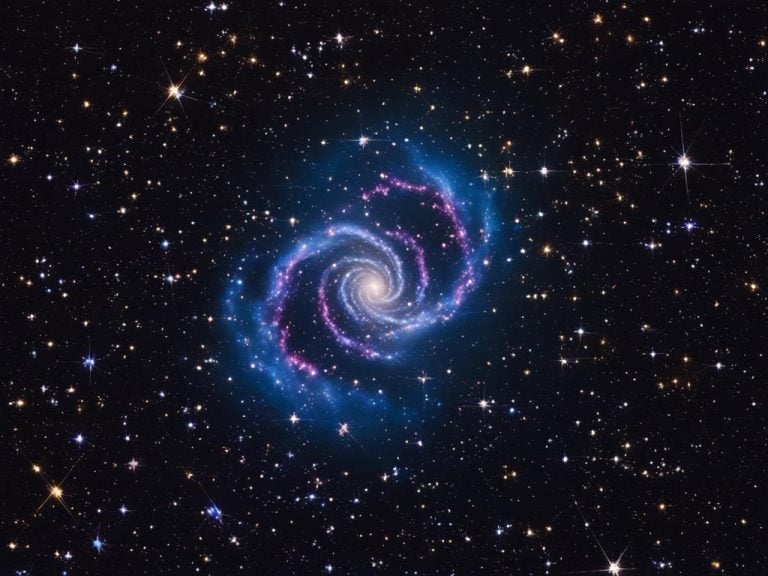Explore the Puppis Constellation: Starry Insights
Did you know the Puppis Constellation is among the 88 official star groups? Ancient people passed it down. Its role in history and myths makes it special. Today, it still fascinates those who love looking at stars. In the south sky, Puppis opens the door to tales of old and new sky sights.

Key Takeaways:
- Discover the rich historical and mythological significance of the Puppis Constellation.
- Learn about the brightest stars and fascinating deep-sky objects within the constellation.
- Get valuable tips for observing and exploring the Puppis Constellation.
- Find out how you can name a star in the Puppis Constellation as a unique and meaningful gift.
- Understand the astronomical significance of the Puppis Constellation in the realm of space exploration.
The Mythology and History of the Puppis Constellation
Explore the fascinating mythology and history of the Puppis Constellation. In Greek myths, Puppis is linked with Princess Andromeda. She faced a sea monster until the hero Perseus saved her using the Argo ship.
During the age of exploration, Puppis helped seafarers find their way at sea. It became a symbol of hope for sailors, guiding them through the unknown. The Puppis Constellation stands for exploring new lands and the strength of the human spirit.
Learn more about Puppis by diving into its myths and history. Discover stories that have been passed down for ages. For more, check SeaSky.org, Wikipedia, and Constellation Guide for in-depth information.
Fascinating Facts about the Puppis Constellation
- The Puppis Constellation covers an impressive area of 673 square degrees, ranking 20th in size among the 88 constellations.
- Within its celestial borders, Puppis harbors three Messier objects, all of which are captivating open star clusters.
- Naos stands as the brightest star in the Puppis Constellation, boasting a visual magnitude of 2.25. Tureis follows closely behind, shining with a magnitude of 2.72, while Turais takes its place as the third brightest star with a magnitude of 2.78.
- The Constellation Puppis is home to remarkable deep-sky objects, including the ancient open star clusters of M46, M47, NGC 2451, NGC 2477, and Messier 93.
- With its captivating mythology, historical importance, and astronomical wonders, the Puppis Constellation continues to captivate astronomers and stargazers alike.
Unveil the wonders of the Puppis Constellation. It combines celestial mythology with our own human history to create a magical story in the night sky.
Brightest Stars in the Puppis Constellation
The Puppis constellation is the 20th largest in the sky. It’s famous for its bright, captivating stars. The Puppis brightest star, Naos (or Zeta Puppis), is nearly 1,400 light-years away. It shines with a magnitude of 2.2, adding a mesmerizing sparkle to the night sky.
Pi Puppis, known as Ahadi, stands out as well. It is about 800 light-years away. This star has a magnitude of 2.7, making it the second brightest in Puppis.
Rho Puppis, or Tureis, is also bright. It’s in the northern part of Puppis, 63 light-years from Earth. With a magnitude of 2.8, Rho Puppis captures the eyes of those looking up at the sky.
L2 Puppis is a star that looks like our sun’s end stage. It has a planet around it at a distance similar to our Earth’s orbit. Stars like Tau Puppis, Naos, and Rho Puppis make a beautiful show in Puppis.
Puppis is a great place for stargazers. With binoculars or a telescope, you can spot open clusters and nebulae. These include M46, M47, NGC 2438, and others, all making Puppis intriguing.
To learn more about the Puppis constellation and its bright stars, visit these links: earthsky.org and theskylive.com.
Deep-Sky Objects in the Puppis Constellation
The Puppis Constellation is a starry paradise for anyone who loves the night sky. It’s full of stunning deep-sky objects waiting to be explored. With a telescope and curiosity, you can see amazing things in this part of space.
Messier 46 is a famous star cluster in Puppis. It’s about 5,500 light-years away and filled with more than 500 young stars. Seeing this cluster is a great chance to watch how stars evolve over time.
Not far from Messier 46 is the Puppis Star-forming region. New stars are born here from huge clouds of gas and dust. This process shows the amazing power of star formation and the forces at work in our galaxy.
The Gum Nebula is also in Puppis, making it even more special. This star-forming area is one of the largest in our galaxy. It’s a massive sight that’s perfect for anyone who loves to photograph the stars and wants to see the universe’s beauty up close.
Visiting the Puppis Constellation is a journey into our galaxy’s heart. Whether you look at star clusters, new star births, or the vast nebulae, it’s a chance to be amazed. Stargazing here will deepen your love for the cosmos.
Exploring the Puppis Constellation: Viewing Tips
To truly see the Puppis Constellation’s beauty, know when and where to look. Follow these tips to enjoy it better:
- Look for a dark spot with not much light around. Puppis is in the southern sky and is best seen from places lower than 25 degrees in the north.
- Use a star map or an app on your phone. They show you which stars and objects belong to the Puppis Constellation. A map can lead you to the M47 cluster, where you can see up to 11 stars with just some binoculars[1].
- Telescopes or binoculars are great for a closer view. They help you see the bright stars and objects better. Try them out for a clearer look at M46 and M47, two big star clusters in Puppis[2].
There’s so much more to learn about the Puppis Constellation and its interesting objects. For in-depth info, here are some sites to visit:
- Astronomy.com has great details on star clusters like M46 and M47 in Puppis.
- Astronomy Now dives deep into the three main Messier clusters in Puppis.
- Universe Today gives lots of info on the Puppis Constellation and its clusters.
Follow these tips and use the online guides to have a great time with the Puppis Constellation. Enjoy the stars!

Naming a Star in the Puppis Constellation
Looking for a unique gift or a special way to remember a loved one? Consider naming a star after someone in the Puppis Constellation. International Star Registry lets you officially name a star. You get a personalized certificate too. This gift shows someone’s special place in the universe.
When you buy a star for someone through International Star Registry, you give a piece of the cosmos. The certificate shows the star’s new name and its sky location. It’s a great gift for birthdays, anniversaries, or any special day.
Naming a star is easy. Just go to International Star Registry’s website at www.starregistry.com. Choose the Puppis Constellation and name a star after someone. The star’s name is kept safe and unique by International Star Registry.
This is a great way to celebrate special moments or show love. A named star in the Puppis Constellation is a gift that lasts forever.
The Significance of the Puppis Constellation in Astronomy
In the study of space, the Puppis Constellation is very important. It is found in the southern sky. This area helps us learn a lot about the Milky Way and what’s in it.
Through the Puppis Constellation, scientists learn about stars and the space between them. They look at stars, nebulas, and clusters to see how space works. This helps them understand how stars live and die, how galaxies form, and the big picture of our universe.
How Puppis fits with other constellations also interests astronomers. Its position lets them compare with neighboring star groups, teaching us more about our universe.
If you want to see cool things, look towards Puppis. It has amazing nebulas like the Gum Nebula. You can also find star clusters there, such as the Puppis Cluster.
The Puppis Constellation shines near Orion and close to Canis Major and Carina. It’s great for people in the south to spot in the sky.
Did you know you can name a star in Puppis? International Star Registry lets you do this. It’s a perfect way to mark a special day. Think of a birthday or anniversary. Naming a star there is a wonderful and unique gift.

- Gain insights into stellar evolution and the interstellar medium
- Explore fascinating objects like nebulae and star clusters
- Locate the Puppis Constellation near other southern constellations
By looking at the Puppis Constellation, astronomers discover more about our cosmos. This adds to our knowledge. It also shows us the wonder and beauty of space.
Conclusion
The Puppis Constellation is all about its spellbinding beauty. It takes you on a journey through the night sky.
It has a rich myth and history. Plus, there are countless stars to admire. It’s a never-ending source of wonder.
Exploring Puppis shows you secrets of the cosmos. You see deep-sky objects that light up space’s vastness.
This is great for both experts and new fans. It offers a chance for unforgettable moments.
Want a special gift? You can name a star in Puppis through International Star Registry. It’s perfect for any special time or a cosmos lover’s dream.
Start your cosmic journey with Puppis. Uncover its secrets and make lifelong memories under the stars.
Learn about its history, myths, and cool facts. Dive into the magic the universe has in store through Puppis.
FAQ
What is the Puppis Constellation?
The Puppis Constellation is part of 88 constellations recognized by ancient cultures. It has a lot of historical and mythological meaning.
Where is the Puppis Constellation located?
It’s in the southern sky surrounded by other constellations.
How can I best view the Puppis Constellation?
Find a dark spot to see it clearly. Use a star map or app to spot stars. Binoculars or a telescope will make it even better.
Can I name a star in the Puppis Constellation?
Yes, you can. International Star Registry lets you name a star and gives a certificate.
What is the significance of the Puppis Constellation in astronomy?
Puppis helps us learn about the Milky Way’s structure. Its place in space helps us understand the whole universe.
Source Links
- Explore the Night Sky: A Beginner’s Guide to the 88 Constellations – https://astrotelescopium.com/blogs/news/unlocking-the-mysteries-of-the-night-sky-a-beginners-guide-to-the-88-constellations
- Observing with NASA – https://mo-www.cfa.harvard.edu/OWN/stars_nebulae.html
- Is there a map where I can see major (at least the 12 zodiac) constellations in the Milky Way Galaxy? I am very curious as to how far the… – https://www.quora.com/Is-there-a-map-where-I-can-see-major-at-least-the-12-zodiac-constellations-in-the-Milky-Way-Galaxy-I-am-very-curious-as-to-how-far-they-are-from-our-solar-system
